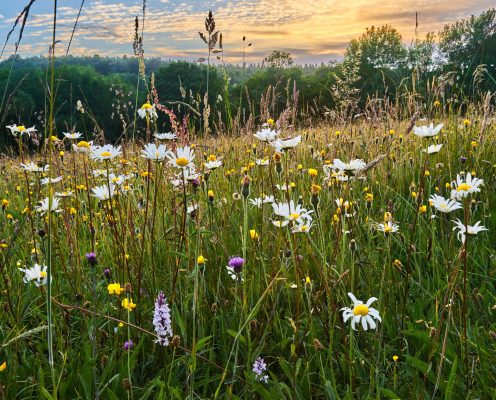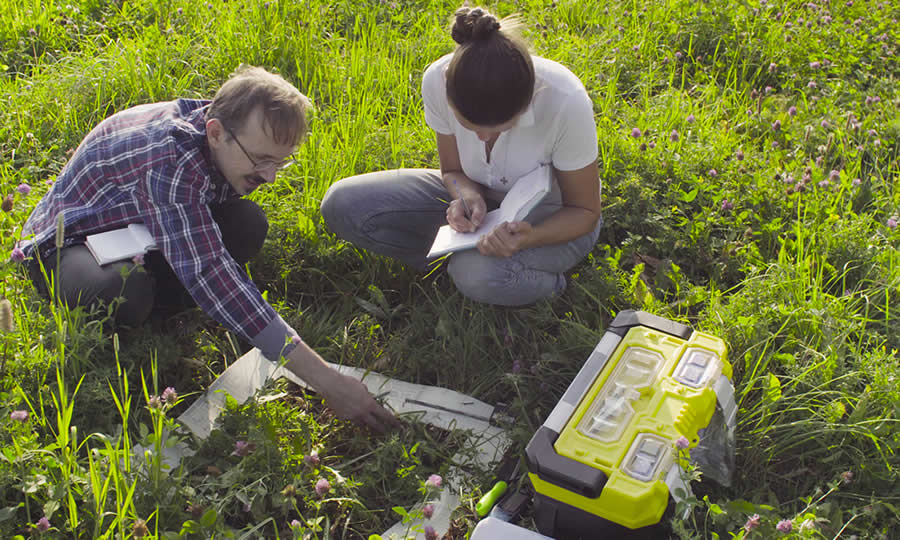Wildflower Seeds for Heavy Clay Soils: Locally Sourced Solutions for Thriving Meadows
Heavy clay soils can challenge gardeners and landowners looking to cultivate vibrant, flourishing meadows. Their dense structure and water retention properties require careful consideration when selecting plant life. However, with the right approach and seed selection, even the heaviest clay soils can be transformed into thriving havens for wildflowers and pollinators. This article explores the intricacies of working with clay soils, the benefits of wildflowers, and how Wildahome’s locally sourced seeds offer a perfect solution for creating beautiful, biodiverse spaces.
Understanding Heavy Clay Soils
What Makes Clay Soils Unique?
Clay soils are characterised by their high clay mineral content, resulting in small, tightly packed particles. This composition leads to poor drainage, as water struggles to percolate through the dense structure. Clay soils are often rich in nutrients, but these can be locked up and unavailable to plants due to the soil’s structure. They can also be slow to warm up in the spring.
Challenges of Growing Plants in Heavy Clay
The challenges of growing in heavy clay soils stem primarily from their poor drainage.Waterlogging can lead to root rot and other fungal diseases. The dense structure can also make it difficult for roots to penetrate and access essential nutrients. Furthermore, clay soils can be challenging to work, becoming sticky when wet and hard when dry.
Why Wildflowers Can Thrive in Clay
Soil Environments Despite these challenges, many wildflowers are uniquely adapted to thrive in clay soils. Their robust root systems can break up compacted soil, improving drainage over time. Native wildflowers have evolved to cope with the specific conditions of their local environment, including the water retention and nutrient availability of clay soils. They often require less maintenance than cultivated varieties, making them ideal for establishing low-maintenance meadows in challenging areas.
Selecting the Right Wildflower Seeds for Clay Soils
Characteristics of Wildflowers Suited for Heavy Clay
Wildflowers that thrive in clay soils typically possess deep, extensive root systems that can penetrate the dense structure. They also tolerate waterlogged conditions and can access nutrients that may be locked up in the soil. Species native to the region are particularly well-suited, as they have adapted to the local climate and soil conditions over generations.
Benefits of Native Wildflowers in Clay Soil Areas
Native wildflowers offer a wealth of benefits in clay soil environments. Their deep roots help to improve soil structure and drainage, while their presence supports a wide range of pollinators and other wildlife. They require minimal maintenance once established, making them a sustainable and cost-effective choice for land management. Furthermore, they contribute to the preservation of local biodiversity.
Why Choosing the Right Seed Mix Matters
Selecting the right seed mix is crucial for success. A well-chosen blend will contain a variety of species suited to the clay soil’s specific conditions, ensuring a diverse and resilient meadow. A mix tailored to clay soils will include species that can tolerate waterlogging, break up compaction, and provide a succession of blooms throughout the year.
Wildahome: Locally Sourced Wildflower Seeds for Heavy Clay Soils
The Importance of Locally Adapted Seed Varieties
Locally adapted seed varieties are essential for successful wildflower meadow establishment. These seeds have evolved to thrive in the region’s specific climate and soil conditions, ensuring better germination rates, greater resilience, and a more natural, balanced ecosystem.
How Wildahome Seeds Are Tailored for UK Clay Soils
Wildahome specialises in locally sourced, native British wildflower seeds and seed mixtures.

Our seed mixes are carefully formulated to address the challenges of heavy clay soils, incorporating species known for their ability to thrive in these conditions. We understand the nuances of UK soil types and select varieties that will flourish in different regions.
Supporting Local Ecosystems with Native Seeds
By choosing Wildahome’s native wildflower seeds, you directly support local ecosystems. Our seeds are sourced responsibly, contributing to the preservation of native flora and fauna. We believe in promoting biodiversity and creating habitats that benefit a wide range of wildlife.
Best Wildflower Species for Heavy Clay Soils
Best Wildflowers for Water-Retentive Clay
For water-retentive clay soils, species like Meadowsweet (Filipendula ulmaria), Purple Loosestrife (Lythrum salicaria), and Common Fleabane (Pulicaria dysenterica) are excellent choices. These wildflowers thrive in damp conditions and provide vibrant displays of colour.
Drought-Resistant Wildflowers for Summer in Clay Soil
Dry spells can occur even in clay soils during the summer. Drought-resistant wildflowers like Yarrow (Achillea millefolium), Bird’s-foot Trefoil (Lotus corniculatus), and Selfheal (Prunella vulgaris) can withstand these conditions and continue to provide valuable resources for pollinators.
Seasonal Wildflower Blooms for Year-Round Interest
To ensure year-round interest, consider a mix that includes species with staggered blooming times. Early spring bloomers like Primrose (Primula vulgaris) and Cuckoo Flower (Cardamine pratensis) are followed by summer favourites like Oxeye Daisy (Leucanthemum vulgare) and Field Scabious (Knautia arvensis). At the same time, autumn brings the late blooms of Devil’s-bit Scabious (Succisa pratensis) and Wild Angelica (Angelica sylvestris).
Preparing Heavy Clay Soils for Wildflower Planting

Testing and Understanding Your Soil
Before planting, it’s essential to test your soil to understand its pH and nutrient levels. This information will help you choose the most appropriate seed mix and determine if any amendments are necessary. A simple home testing kit or a professional soil analysis can provide valuable insights.
Improving Drainage and Structure in Clay Soil
While drastically altering the composition of clay soil is not always necessary or desirable, some improvement to drainage and structure can be beneficial. Adding organic matter, such as compost or well-rotted manure, can help to loosen the soil and improve its water-holding capacity.
Tips for Soil Preparation Without Changing Its Natural Characteristics
The aim is to create a suitable environment for wildflowers without significantly altering the natural characteristics of the clay soil. Lightly cultivating the top layer of soil and removing any large clumps can create a better seedbed. Avoid excessive tilling, disrupting the soil structure and bringing weed seeds to the surface.
How to Sow Wildflower Seeds in Heavy Clay Soils
Step-by-Step Guide to Planting Wildflower Seeds in Clay
1. Prepare the soil by lightly cultivating the top layer and removing debris.
2. Mix the wildflower seeds with a carrier, such as sand or fine compost, to ensure even distribution.
3. Sow the seeds evenly over the prepared area.
4. Gently press the seeds into the soil using a roller or the back of a rake.
5. Water the area lightly but thoroughly.
Techniques for Ensuring Germination in Dense Soils
In dense clay soils, it can be helpful to create small pockets or furrows to sow the seeds, providing them with a slightly looser environment for germination. Ensure the seeds are in contact with the soil and keep the area moist until germinating. Best Times of Year for Planting Wildflower Seeds in Clay Soil The best time to sow wildflower seeds in clay soil is typically in the autumn or early spring. Autumn sowing allows the seeds to experience a period of cold stratification, which can improve germination rates. Spring sowing should be done as soon as the soil is workable.
Caring for Wildflowers in Heavy Clay Soils
Maintaining Wildflowers Through Seasonal Changes
Once established, wildflowers require minimal maintenance. Monitor the meadow for any invasive weeds and remove them as needed. Some light watering may be necessary in dry periods, particularly in the first year.
Watering and Weed Management in Clay Soil Areas
Watering should be done sparingly, as overwatering can exacerbate drainage issues in clay soils. Focus on targeted watering during dry spells, mainly when the wildflowers are established. Weed management should focus on removing invasive species that compete with the wildflowers for resources.
Encouraging Natural Self-Seeding for Future Growth
Allowing wildflowers to set seed naturally will ensure a continuous supply of new plants in subsequent years. Avoid cutting the meadow too early in the season, allowing the flowers to mature and disperse their seeds.
The Benefits of Wildflowers in Heavy Clay Soil Areas
Improving Soil Health and Reducing Compaction
Wildflower roots help to break up compacted clay soil, improving drainage and aeration. The organic matter added to the soil by decaying plant material further enhances soil health and fertility.
Attracting Pollinators and Local Wildlife
Wildflower meadows provide pollinators valuable habitat and food sources, including bees, butterflies, and hoverflies. They also attract other wildlife, such as birds and small mammals, creating a thriving ecosystem. Enhancing the Landscape with Low-Maintenance Beauty
Wildflower meadows offer a beautiful, low-maintenance alternative to traditional lawns or cultivated gardens. They provide a constantly changing display of colour and texture throughout the year, enhancing the landscape and providing a sense of connection to nature.
Why Wildahome Seeds Are the Best Choice for Locally Sourced Wildflower Seeds for Heavy Clay Soils
The Importance of Locally Sourced Wildflower Seeds for Heavy Clay Soils
Using locally sourced seeds is essential for maintaining healthy ecosystems and ensuring successful plant growth. Native seeds are naturally adapted to the local climate and soil conditions, making them more resilient and better suited to thrive. By choosing Wildahome’s locally sourced wildflower seeds, you’re enhancing biodiversity and supporting the long-term sustainability of native plant populations.
Commitment to Sustainability and Local Sourcing
Wildahome is committed to sustainability and local sourcing. Our seeds are sourced responsibly from native British wildflowers, preserving local biodiversity and supporting local ecosystems.
Proven Success of Wildahome Seeds in Challenging Soil Types
Our seed mixes, including heavy clay, are specifically formulated for UK soil conditions. We have a proven track record of helping customers establish thriving wildflower meadows in challenging environments.
Frequently Asked Questions: Wildahome Wildflower Seeds for Heavy Clay Soils
I have heavy clay soil that’s constantly waterlogged. Will Wildahome wildflower seeds grow there?
Absolutely! We specialise in native British wildflower seed mixes explicitly tailored for the challenges of heavy clay soils.1 Our mixes include species known for their tolerance of damp conditions and ability to improve soil structure over time. While your soil may be challenging, our carefully selected seed varieties are designed to thrive in it.
What’s the difference between a general wildflower seed mix and one for heavy clay?
General wildflower mixes often contain species that prefer well-drained soils. These may struggle or fail to establish in heavy clay. Our heavy clay mixes prioritise wildflowers with robust root systems and tolerance for water retention. They’re also selected for their ability to break up compacted soil, improving drainage naturally.
When is the best time to plant wildflower seeds in heavy clay soil?
Autumn or early spring are ideal. Autumn planting allows seeds to experience a period of cold stratification over winter, which can improve germination. Spring planting should be done as soon as the ground is workable. Avoid planting during the hottest summer or when the ground is frozen.
How do I prepare my heavy clay soil before sowing wildflower seeds?
While you don’t need to change the soil’s composition drastically, some preparation is helpful. Lightly cultivate the top layer to create a loose seedbed and remove any large clumps or debris. Adding organic matter, like compost, can also improve drainage and fertility. Avoid deep tilling, as this can disturb the soil structure and bring weed seeds to the surface.
How much maintenance will a wildflower meadow in heavy clay require?
One of the great benefits of a native wildflower meadow is its low maintenance. Once established, it generally requires minimal intervention. You might need to do light weeding, especially in the first year, and ensure that more aggressive plants don’t overtake the meadow. In very dry spells, some light watering might be necessary. Allowing the wildflowers to self-seed will ensure the meadow’s continued health and vibrancy.
Are Wildahome seeds sourced locally?
Yes, absolutely! We are a family-owned UK business, and we are passionate about supporting local ecosystems.8 Our seeds are sourced responsibly from native British wildflowers, ensuring that they are well-adapted to the specific conditions of UK soils and climates, including heavy clay.
What if I’m unsure which seed mix is right for my clay soil?
We understand that every garden and soil type is unique. We are always happy to offer guidance. Please feel free to contact us with details about your soil, location, and desired outcome, and we’ll do our best to recommend the perfect Wildahome wildflower seed mix for your needs. We want to help you create a thriving, beautiful wildflower meadow!
Buy Wildflower Seeds For Heavy Clay Soils

